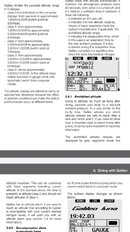kirstyjay
Registered
I live 600-700m above sea level and I am trying to research possible dive computers that would let me know when it's safe to return home after a dive.
The variety of computers available is simply mind-boggling, so if anyone has any suggestions, I'd appreciate it.
I'm a newly qualified PADI OWD, but I live in the Canary Islands with ample opportunities to dive, so I would think that I'll be going at least once a month and would like to invest in some kit that would reflect this frequency of diving, regardless of price. I'd rather save up and buy something I'll use for years than have to spend more replacing stuff later.
Many thanks!
Kirsty
The variety of computers available is simply mind-boggling, so if anyone has any suggestions, I'd appreciate it.
I'm a newly qualified PADI OWD, but I live in the Canary Islands with ample opportunities to dive, so I would think that I'll be going at least once a month and would like to invest in some kit that would reflect this frequency of diving, regardless of price. I'd rather save up and buy something I'll use for years than have to spend more replacing stuff later.
Many thanks!
Kirsty




